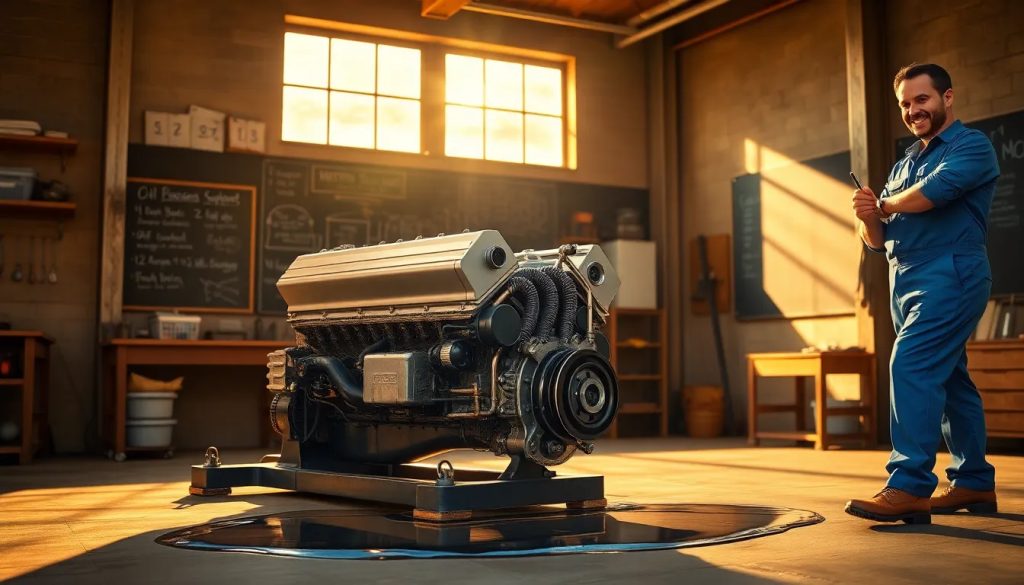Detroit Series 60 because oil passes into water: causes and solutions

Detroit Series 60 engines are renowned for their durability and performance, but they are not without their issues. One common problem that many owners face is the mixing of oil and coolant, which can lead to expensive repairs and engine failure. Understanding the root causes of this issue is crucial for effective troubleshooting and resolution.
This article will delve into the common causes, diagnosis, and solutions associated with the Detroit Series 60 engine oil contamination issue. By gaining insights into this matter, you can better maintain your engine and prevent costly repairs.
- What are the common causes of oil in coolant for Detroit Series 60?
- How can you diagnose oil contamination in the coolant?
- What solutions are effective for Detroit Series 60 oil in water issues?
- What to check if your Detroit Series 60 is mixing oil and water?
- How does cavitation affect the Detroit Series 60 engine?
- What are the signs of a faulty oil cooler in Detroit Series 60?
- Questions related to oil contamination in Detroit Series 60 engines
What are the common causes of oil in coolant for Detroit Series 60?
Several factors can lead to oil mixing with coolant in the Detroit Series 60. One significant cause is cavitation, a phenomenon where vapor bubbles form and collapse within the cooling system, potentially damaging engine components. This can further lead to oil contamination.
Another common culprit is a faulty oil cooler. If the oil cooler develops a leak, it can allow oil to flow into the coolant system, leading to the mixing of these fluids. Additionally, worn O-rings or pitted liners can also contribute to this problem. These components can fail over time, allowing oil to seep into the coolant passages.
- Cavitation damage to engine components
- Faulty oil cooler
- Worn O-rings
- Pitted cylinder liners
Regular maintenance and inspections are essential to identify these issues early. If you notice signs of oil in your coolant, it’s crucial to address the problem promptly to avoid more severe engine damage.
How can you diagnose oil contamination in the coolant?
Diagnosing oil contamination in your coolant system requires a systematic approach. Start by visually inspecting the coolant. If it appears milky or has an oily sheen, this can indicate oil contamination. A simple test is to collect a sample of the coolant and observe it for unusual properties.
Another diagnostic method is checking the oil level. If the oil level is rising unexpectedly, this could be a sign that coolant is leaking into the engine. Using a pressure tester can also help identify leaks within the cooling system. This tool increases pressure in the system, allowing you to see where leaks might occur.
- Visual inspection of coolant for oil presence
- Checking oil levels for unexpected increases
- Using a pressure tester to identify leaks
Additionally, conducting a compression test can help assess the integrity of your engine’s seals and gaskets. If there are significant discrepancies, it may indicate where the contamination is occurring.
What solutions are effective for Detroit Series 60 oil in water issues?
Addressing the issue of oil mixing with coolant requires a multifaceted approach. First and foremost, it is essential to identify the root cause. If a faulty oil cooler is to blame, it must be replaced immediately. Neglecting this can lead to ongoing problems.
In some cases, replacing O-rings and gaskets can resolve contamination issues. If the cylinder liners are pitted, it may be necessary to perform a more extensive engine overhaul, which can involve costly repairs but is vital for long-term engine health.
- Replace faulty oil cooler
- Change O-rings and gaskets
- Consider engine overhaul for pitted liners
An important tip is to flush the cooling system thoroughly after repairs. This step ensures that any remaining oil is removed, preventing further contamination. Regular maintenance checks can help identify potential issues before they escalate into serious problems.
What to check if your Detroit Series 60 is mixing oil and water?
If you find that your Detroit Series 60 is mixing oil and water, there are several critical areas to inspect. Start with the oil cooler, as this is a common fail point. Look for signs of leaks or any physical damage.
Next, inspect the engine block for any signs of erosion or damage. The condition of the O-rings and cylinder head gaskets should also be evaluated, as these components play a crucial role in keeping oil and coolant separate.
- Examine the oil cooler for leaks
- Inspect the engine block for erosion
- Check the condition of O-rings and gaskets
Additionally, consider the water pump and its efficiency. A malfunctioning water pump can exacerbate cooling issues, leading to overheating and further complications. Regular maintenance of these components is vital for preventing oil and coolant mixing.
How does cavitation affect the Detroit Series 60 engine?
Cavitation can have devastating effects on the Detroit Series 60. When vapor bubbles form within the cooling system, they can implode with great force, leading to erosion of the metal surfaces. This erosion can create pathways for oil and coolant to mix, exacerbating contamination problems.
Furthermore, cavitation can compromise the cooling system's efficiency, leading to overheating and increased stress on engine components. If not addressed, these issues can lead to significant engine damage and costly repairs.
Owners should be vigilant about monitoring their cooling systems for symptoms of cavitation, such as unusual noises or signs of overheating. Regular inspections and maintenance can help mitigate these risks.
What are the signs of a faulty oil cooler in Detroit Series 60?
A faulty oil cooler may exhibit several symptoms that can indicate a problem. One of the most noticeable signs is the presence of oil in the coolant, as previously discussed. If you observe this, it’s likely that the oil cooler is compromised.
Another sign is fluctuating oil pressure; if the oil pressure gauge indicates irregularities, this might point to a malfunctioning cooler. Additionally, if the engine is overheating, this can also suggest that the oil cooler is not performing effectively.
- Presence of oil in coolant
- Fluctuating oil pressure
- Engine overheating
Prompt inspection and replacement of a faulty oil cooler can prevent further damage to your engine. It is essential to pay attention to these warning signs to maintain the health of your Detroit Series 60 engine.
What causes an engine to mix oil and water?
There are several reasons why an engine might mix oil and water. Common causes include a faulty oil cooler, worn gaskets, or cylinder head issues. These failures allow oil to enter the coolant system, leading to contamination. Regular maintenance and inspections are vital to catch these problems early.
What is the problem with the Detroit 60 series engine?
The Detroit 60 series engine is known for its robust performance, but it can encounter issues such as oil mixing with coolant. This problem often stems from cavitation, faulty oil coolers, or worn seals, which can lead to significant engine damage if not addressed promptly.
What would cause oil to be in the coolant reservoir?
Oil in the coolant reservoir is typically caused by a leak in the oil cooler, which allows oil to seep into the cooling system. Additionally, worn gaskets or cylinder head issues can also contribute to this problem, leading to potential engine failure if not promptly repaired.
How do I stop my coolant from mixing with oil?
To stop coolant from mixing with oil, it’s crucial to identify the root cause of the issue. This often involves replacing faulty components such as the oil cooler or gaskets. Flushing the cooling system to remove any existing contamination is also necessary to ensure the engine operates cleanly.
 Fault code 31 detroit series 60 troubleshooting guide
Fault code 31 detroit series 60 troubleshooting guide Code 128 Detroit series 60: what it means and how to fix it
Code 128 Detroit series 60: what it means and how to fix it White smoke from a Detroit Series 60 engine: causes and solutions
White smoke from a Detroit Series 60 engine: causes and solutions Code 77 Detroit Series 60: Understanding the Fault
Code 77 Detroit Series 60: Understanding the FaultIf you want to know other articles similar to Detroit Series 60 because oil passes into water: causes and solutions you can visit the category DETROIT.
Leave a Reply

RELATED POSTS